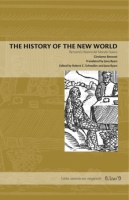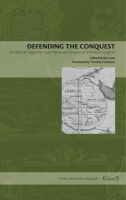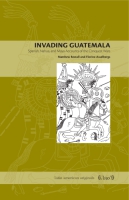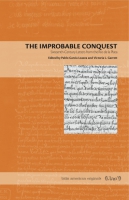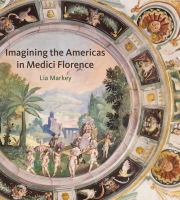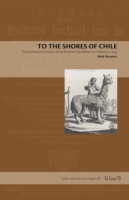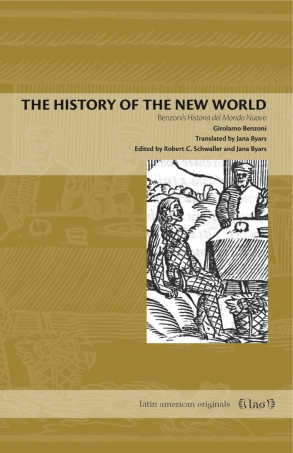
The History of the New World
Benzoni's Historia del Mondo Nuovo
Girolamo Benzoni, translated by Jana Byars, and edited by Robert C. Schwaller and Jana Byars
The History of the New World
Benzoni's Historia del Mondo Nuovo
Girolamo Benzoni, translated by Jana Byars, and edited by Robert C. Schwaller and Jana Byars
“[A] very readable, nimble translation. . . . Benzoni is indeed recommended reading for all courses and discussions considering the birth and girth of global modernity.”
- Description
- Reviews
- Bio
- Table of Contents
- Sample Chapters
- Subjects
First published in Venice in 1565, Benzoni’s book was an immediate best seller and available in at least five languages before the end of the century. It spanned the years 1541–56, providing detailed descriptions of native flora and fauna, exciting narration of harrowing exploits, and a surprisingly critical perspective on the expanding Spanish Empire’s methods of conquest and governance, in which Benzoni highlighted the struggles of indigenous peoples. This edition follows the three-book structure of the original account but focuses on Benzoni’s own experiences, omitting episodes to which he was not a witness and excising repetition and hyperbolic hearsay.
The first English-language version published since 1847, this volume includes an informative introduction and annotations that situate Benzoni and his fascinating writings in the larger context of Spanish colonial conquest. Perfect for classroom use, this is a lively, vivid firsthand account of the adventure and wonder of the New World.
“[A] very readable, nimble translation. . . . Benzoni is indeed recommended reading for all courses and discussions considering the birth and girth of global modernity.”
“Long sampled by Spain’s enemies in search of ‘Black Legend’ propaganda, Girolamo Benzoni’s gripping 1556 account of his misadventures in early Spanish America has rarely been treated on its own as a tale of personal survival and rare ‘foreign’ witness to conquest and its aftermath. Surprisingly direct and accessible, The History of the New World benefits tremendously from Jana Byars’s new translation and from her and Robert Schwaller’s careful editing and introduction, which will help today’s readers navigate Benzoni’s wild tales of lost treasure, shipwreck, jungle warfare, and human sacrifice.”
“Robert Schwaller and Jana Byars provide an engaging translation of Benzoni that contextualizes his work within modern scholarship on the early modern Atlantic world as well as recent historical research on the Americas. They are careful to point out that this eyewitness account provides valuable information about the New World, but they also demonstrate how and why the History is not always to be trusted for its accuracy. This book will be greatly appreciated by students and scholars of Latin American history, cross-cultural exchange in the Renaissance, and travel writing.”
“Probably as well known in early modern Europe as Las Casas’s Brevísima relación, Girolamo Benzoni’s Historia del Mondo Nuovo has finally been given a full, modern, scholarly English translation. More than another chapter in the Black Legend, Benzoni’s Historia is an example of the political, economic, and religious writing that shaped Europe’s perceptions of the Spanish project in the New World, and Robert Schwaller and Jana Byars’s well-annotated edition makes it accessible for researchers of all levels.”
“Jana Byars and Robert Schwaller’s highly accessible edited translation of Benzoni’s adventures will be a valuable vehicle for teaching the early history of the New World. Benzoni’s references to crucial themes in colonial history and his unsubtle discourse regarding the Spanish conquests will certainly stimulate classroom discussions ranging from the Black Legend debate to the usefulness and pitfalls of firsthand travel accounts. This new edition will add yet another indispensable primary document to our collection of historical references for Anglophone students.”
Jana Byars is Assistant Professor of History at Iowa State University.
Robert C. Schwaller is Assistant Professor of History at the University of Kansas and the author of Géneros de Gente in Early Colonial Mexico: Defining Racial Difference.
Contents
List of Illustrations
Acknowledgments
Introduction
The History of the New World
Book I
Book II
Book III
Bibliography
Index
Introduction
“Being young, only twenty-two, and desiring to see the world like many others, and having heard word of the new countries just discovered in the Indies many call the New World, I determined to go.” In his opening sentence, Girolamo Benzoni explains to his audience exactly why he braved a transatlantic crossing in 1541. Like many of his contemporaries, he sought adventure. He definitely found it, traversing breathtaking surroundings, encountering tattooed and pierced natives, engaging in deadly battles, and barely surviving almost continual hardship. More than once, Benzoni found himself at death’s door yet managed to escape with his life. Although his travels are presented as an adventure tale, he had a less glamorous motive for traveling across the globe: Benzoni was a merchant. In his travels throughout the Americas, he pursued various trade ventures. It is difficult to judge just how successful he was at finding his riches. He omits most of his business dealings; only rarely does he provide details on the price of wine or gold. He certainly asserts his prosperity, telling his readers that he made a fortune and was ready to bring a load of gold back to Milan. Like other early travelers, Benzoni became an amateur naturalist. He recorded detailed descriptions of indigenous flora and fauna, almost always oddly colored by the pressing pains of hunger or thirst. At the same time, his writings engage in explicit political commentary. Although a traveler in Spanish America, he despised the Spanish. At almost every turn, Benzoni criticizes Spanish methods of conquest and governance, while frequently siding with Native Americans.
More than a decade after he initially departed northern Italy for parts unknown, he found himself expelled from the overseas kingdoms of Spain. He packed his thousands of ducats and left, set to retrace his steps to Europe. Unfortunately, he suffered shipwreck and inclement weather before he got far. He had to stay in Havana for several miserable months waiting for a vessel strong enough, and weather good enough, to carry him home. He ultimately arrived in Spain in 1556, penniless, exhausted, and full of stories. With nothing left to peddle but his memories, he decided to write them down in his History of the New World. Originally published in 1565, Benzoni’s history quickly captured the attention of readers across Europe.
Benzoni’s narrative contributed to a growing corpus of travel narratives that related the explorations and adventures of Europeans as they traveled to parts unknown. His work was very well received for several reasons: he included harrowing stories, he offered descriptions of the indigenous animals and plants that Europeans had never even imagined, and he described a completely new group of people and beliefs. Just as Spain’s continental ascendency seemed unstoppable, Benzoni offered a vitriolic description of the barbarity of the Spanish that brought their moral authority to rule and exploit the New World into question. The mix of adventure, exotic people and places, and anti-Spanish diatribe made The History of the New World an immediate best seller. Benzoni’s narrative provides a unique firsthand account of the Spanish conquest by an Italian. Its anti-Spanish rhetoric represents an understudied but historically significant contribution to the Black Legend of Spanish colonialism. As a whole, The History of the New World provides readers with a rich ethnographic text that offered its early modern readers a tantalizing blend of travelogue, adventure tale, and anti-Spanish propaganda.
Benzoni and the Early Modern Travel Narrative
Most of the very little we know for certain about Benzoni comes from his first line: he left for the Indies in 1541, when he was twenty-two. Other clues come from his two dedications. The second (and shorter) dedication was written in 1572, so we know that he was still alive at that point. In the first, written in 1565, Benzoni tells Pope Paul IV that he is the child of a “humble father,” from a “house gone to ruin, in part because of the continuing war, and just as much because fortune has always been [his family’s] enemy.” Because his father could not support him at university, he instead sent Benzoni throughout Europe, to “various provinces: France, Spain, Germany, and the other cities in Italy.” It was in these distant cities that he first heard of the wonders of the New World and developed an “extreme desire” to go. Though he never again speaks directly of his upbringing, the narrative supports his claim to be a down-on-his-luck merchant and curious traveler.
Benzoni’s book has a longer and better-documented pedigree. La historia del Mondo Nuovo was first published in Venice in 1565; it was reissued in 1572 with some minor changes. Far more copies of this second edition are extant, suggesting a larger run. The book was translated and republished quickly. Urban Chauveton translated it into Latin; this edition was published in Geneva by Eustathium Vignon in 1578. The same team issued a French translation in 1579. Nicholas Höniger, a German, translated the work into German from Chauveton’s Latin; it was published in Basel in 1579. Benzoni was translated into Dutch in 1610. Europeans were able to read about a dozen more translations and editions by the end of the sixteenth century, and quite a few more in the early seventeenth. There were thirty-two editions in all. The book languished for about a century, until the appearance of a new French translation in 1835. Unsurprisingly, Benzoni’s hispanophobic text was translated into Spanish only in 1967, and even then only in the colonies, in Caracas, Venezuela. It was not published in Spain proper until 1989.
Anglophones had access to a bit of Benzoni from the early seventeenth century on. The English cleric Samuel Purchas translated and edited a collection of travel narratives by “Englishmen and others” in 1625. He included six pages from Benzoni, whom he called “Jerome Benzos,” in his fourth volume. None of Benzoni’s book was rendered into English again until the mid-nineteenth century, when the Hakluyt Society—a group founded in 1846 in London to further the study of exploration—published it in its entirety in 1857. The “entirety” is part of why we have chosen to issue this new translation and edition. At its best, Benzoni’s account captures the reader’s imagination with its rich first-person details and unique perspective. At other times, Benzoni copies other authors almost word for word, passing on specious information with nary a comment. Moreover, the 1857 translation, though serviceable, is clunky and more than a little dated. The current edition contains material written only by Benzoni himself; from the whole text we have skimmed much of the chaff.
Europeans had always loved stories offering adventure in faraway lands and novel, often “monstrous,” people. The Greeks told a tale of Hercules stealing the belt of Hippolyte, the Amazon queen, in a distant land. In the Middle Ages, Europeans voraciously consumed the stories of Marco Polo, Odoric of Pordenone, and Sir John Mandeville, with little thought for veracity or even verisimilitude. Rather, the more amazing or awe-inspiring, the better, even if the descriptions were inexact and difficult. Stephen Greenblatt likens the European response to the New World to the “startle reflex” in infants: “eyes widened, arms outstretched, breathing stilled, the whole body momentarily convulsed.” Europeans reached for the Western Hemisphere, with its endless jungles, enormous mountains, and strange people unlike anyone ever encountered. Yet that startled moment also contained a flash of panic. This wonder, as Greenblatt characterizes it, involved not only a desire to possess and understand but also more than a hint of terror and horror. Naked cannibals, monstrous beasts, entire societies existed outside of God’s plan, and they were dreadful as well as captivating. And so Benzoni’s narrative arrived at just the right time. Europeans were in the first throes of New World fever. They consumed more travel literature than ever before and panted over tales of adventure from those recently returned from strange new lands.
The travel literature of the early modern period helped to explain to Europeans not only the newly discovered territories but also how the Old World fit into a new global paradigm. As Claude Lévi-Strauss wrote in his memoir Tristes tropiques, “Every landscape appears first of all as a vast chaos, which leaves one free to choose the meaning one wants to give it.” Explorers arrived in the New World with a cultural paradigm that they imposed upon the world they found. They understood their world within that framework and transmitted it to their readers. Practically speaking, unique animals were likened to familiar beasts of burden. But beyond that, Europeans rendered the utterly unknown into something culturally identifiable. For instance, Hakluyt rendered naked Indians in the New World as the ancient Picts in imagery. This gave contemporary Europeans a ready category—“savage”—and a narrative for growth: barbarians from Europe became the entirely civilized British Empire. These naked Indians could also become delightful Christian citizens.
Benzoni certainly makes use of this schema. He accentuates the savagery in the Americas, be it via an exhausting passage on bloodthirsty mites capable of crippling a grown man overnight, or magniloquent descriptions of genuine man-eating Indians. He sets up a very clear asymmetrical dichotomy between the indigenous and the Europeans, with religion as his first line of demarcation: superior European Christian opposite inferior pagan indigenous. Benzoni occasionally refers to the indigenous as “brute beasts” in his narration of their senseless pagan rituals, their willingness to murder their children, and their horrifying habit of consuming their neighbors. But he often presents these atrocities in concert with the even greater horrors perpetrated by the Spaniards. The Indians kill their children in abominable ways, but only to save them from greater abuses at the hands of the Spaniards. Yet there were clear distinctions even within the ranks of the Christians, and Benzoni wants to emphasize them. For Benzoni, and his contemporaries, the Spaniards and Italians represented two different peoples endowed with different moral and cultural characteristics. Benzoni often writes of Spanish foolishness, yet he rarely compares Spaniards and Italians directly. Instead, he makes his anti-Spaniard point by contrasting his fellow Christians with the indigenous. The indigenous may be cannibals, but they are generous when compared to the Spaniards. The Spaniards appear not only as vicious monsters but also as very bad Christians.
The Spanish Empire and the Black Legend
Benzoni’s hatred of Spaniards was not unreasonable. Spain was arguably the most powerful country in Europe during the years Benzoni spent tramping through the Americas, and its power was bolstered and maintained by the copious riches of the New World. The marriage of Ferdinand of Aragon and Isabel of Castile in 1469 set the stage for the unification of Spain. In 1492, the end of the Reconquista and the expulsion of the Jews and Muslims furthered their nationalist project. The couple wisely negotiated strategic marriages for their children, most notably pairing their daughter Juana with the Habsburg Philip the Handsome, son of the Holy Roman Emperor. Philip and Juana gave birth to a son, Charles, who became king of Castile and Aragon in 1516, and would be the first monarch to rule those territories with the title king of Spain. The initial union of Castile and Aragon probably did not worry other European kingdoms. In 1520, however, Charles succeeded his grandfather Maximilian and became Charles V, the Holy Roman Emperor and archduke of Austria. Such a confluence of dynastic providence was certainly cause for alarm.
By the 1520s, Charles controlled huge chunks of Europe, including the Netherlands, Austria, Hungary, and much of northern Italy, as well as territories in the New World. After inheriting such vast estates, Charles spent most of his life defending them from his rivals. In Italy, Charles would spend thirty years fending off French invasions and internal Italian challenges. As Holy Roman Emperor, he struggled to contain the outbreak of the Protestant Reformation and the vicious warfare it unleashed. In the Americas, French and English pirates threatened his colonists and his treasury. Even the expanding Ottoman Empire encroached on his Austrian possessions. In 1554, Charles chose to retire to a monastery, bequeathing the Holy Roman Empire to his brother, Ferdinand, and leaving Spain, and its empire, to his son, Philip II, who remained embroiled in conflict throughout the sixteenth century.
Benzoni’s personal experience with this history came through a set of these conflicts called the Italian Wars. Waged between 1494 and 1559, these wars involved most of the major European kingdoms, as they each vied for power over the Italian Peninsula. Benzoni’s home, the Duchy of Milan, was constantly at war during this period. Although the Milanese could have developed a grudge against many foreign interlopers, including the papacy, the French, the Florentines, the Ottomans, and the Venetians, among others, the Spanish were the worst. In 1535, Francesco Sforza died without an heir, leaving the Duchy of Milan without a native ruler. Charles V took it over without fanfare. That move sparked a brief encounter between the Spaniards and the French from 1536 to 1538. A much more significant war involving the Ottoman Empire took place between 1542 and 1546 and then again from 1551 to 1559. Benzoni departed for the Americas in 1551, war breaking out around him again as France and Spain fought for control of his homeland. His anger toward the Spanish and the machinations of Charles V stemmed in part from this experience. Given the scope of conflicts involving the Habsburgs, other Europeans came to adopt similarly negative views of the Spanish.
Although derogatory descriptions of the Spanish have persisted since the sixteenth century, this pattern of national stereotyping received no serious scholarly attention until the twentieth century. In 1914, the Spanish scholar Julián Juderías dubbed the anti-Spanish stereotype the “Black Legend.” Since then, scholars have heatedly debated the origins and implications of the term. At its core, the Black Legend portrays Spaniards as harsh conquerors and colonizers, ruthless in their dealings with Native Americans and exploitive of the land and people under their rule. The Black Legend and the various stereotypes it comprises must be understood as a historical process. It did not spring into existence suddenly but was shaped by interactions between competing European groups in Europe and the Americas. The conflicts that routinely pitted Spain against France, England, or Italian city-states fostered antagonism toward the Spanish, and Spain’s colonization of the New World provided new fuel for older animosities. Benzoni’s own bias against Spaniards was probably rooted in the expansion of the Kingdom of Aragon into the Mediterranean and Italian Peninsula in the fifteenth century, a process that encouraged negative stereotypes of the Aragonese as mercenaries and bad Christians. Such views persisted in the sixteenth century in response to Spanish participation in the Italian Wars. These earlier biases, and Benzoni’s personal experience in the Italian Wars, preconditioned his view of Spanish conquest in the Americas.
The single most cited source of anti-Spanish stereotypes has been the work of the Spanish conquistador-turned-missionary Bartolomé de Las Casas. Since its initial publication in Spanish in 1552, European rivals have used Las Casas’s Short Account of the Destruction of the Indies to denounce the cruelty of the Spanish. Benzoni’s History of the New World, by contrast, is largely unknown to modern audiences. It is tempting to assume that Benzoni’s obscurity reflects the later publication of his narrative, which appeared in print thirteen years after Las Casas’s Short Account captured the attention of European critics. But this is not the case. In fact, Benzoni’s History of the New World may have reached more European readers in the sixteenth century than the Short Account did.
After its initial publication in Italian in 1565, The History of the New World was reissued in 1572 and quickly translated and disseminated in Latin (1578), French (1579), German (1579), and Dutch (1610), as noted above. Las Casas’s Short Account was not translated until 1578, when it appeared in Dutch. By roughly the same date, Benzoni’s History was available to Italian, French, and German readers, and educated readers could read it in Latin. By the end of the century, the Short Account had gained ground, with translations into French (1579), English (1583), and German (1599). Although the relative size of readership cannot be determined, the popularity of The History of the New World certainly rivaled or exceeded that of the Short Account during the second half of the sixteenth century.
Nevertheless, in the long sweep of history, Las Casas’s writing continued to be mobilized as anti-Spanish propaganda long after Benzoni’s History of the New World fell into obscurity. One reason for Las Casas’s ascendency over the long haul involves the successive republication of the Short Account during periods of conflict between Spain and its European rivals. English translations, for example, appeared in 1583, 1625, 1656, 1689, 1699, and 1745. Each of these reprintings coincided with heightened tensions between Spain and England. Between 1552 and 1750, the Short Account appeared in at least thirty-four editions, the majority of them published by Spanish rivals. At least fourteen Dutch editions appeared in the seventeenth century alone. By the end of the eighteenth century, six editions had appeared in English and six in French. The staying power of Las Casas’s Short Account lies in its focused, well-argued, polemical attack on the Spanish conquest and its participants. In contrast, The History of the New World mixes critique with travelogue, history, geography, and adventure. While Las Casas relentlessly describes atrocity after atrocity, Benzoni’s narrative meanders, jumping between past and present and mixing history, hearsay, and personal anecdotes. While Benzoni’s style of writing clearly captured the imagination of sixteenth-century Europeans who sought news from the Americas, by the seventeenth century, Las Casas’s brutal direct attack proved more enticing to European readers eager to vilify the Spanish in the midst of international conflict. Benzoni’s work faded into obscurity because its style no longer appealed to European audiences. Nevertheless, the early fascination with Benzoni makes his History a formative source for the development of the Black Legend.
Spanish America Before Benzoni
Although Benzoni’s narrative was one of the earliest histories of the Americas, he arrived in the New World almost fifty years after Columbus first claimed Hispaniola for the Spanish. During that half century, many of the most populous societies of the Americas were conquered, among them the Aztecs, Incas, Mayans, and Muiscas. But the Spanish conquests of the Americas were by no means finished, as Benzoni learned firsthand during his travels.
The strategies, tactics, and patterns of Spanish conquest in the Americas did not develop in isolation. For nearly eight hundred years (711–1492), Christian kingdoms in Iberia waged on-again off-again war against Muslim caliphates. These wars were commonly known as the Reconquista (Reconquest) because Christians viewed their struggle as an attempt to conquer areas lost to Muslim conquests of the eighth century. The Reconquista ended in 1492, when Ferdinand and Isabel, co-monarchs of the kingdoms of Castile and Aragon, conquered the last caliphate. The simultaneous ending of the Reconquista and the discovery of the New World allowed for a seamless transition between the conquest of Iberia and conquest in the Americas.
Significantly, the men who fought to expand Spain’s territory in the Americas did so as private individuals, not as uniformed soldiers of the king’s army. Rather than command a large standing army, Iberian monarchs commissioned individuals, often nobles or wealthy subjects, to raise “companies” of troops. Those who commanded companies of soldiers were promised rewards for successful campaigns that might include noble titles, tax exemptions, political office, or financial remuneration. For example, before setting out on his voyage, Columbus entered into a contractual agreement with Ferdinand and Isabel that stipulated the rewards he would receive for a successful venture. Similar agreements were made between successive prospective conquistadors and the monarchs. The kings of Spain did not finance these expeditions; they promised future rewards for privately organized and funded campaigns.
Conquistadors organized themselves in companies that resembled modern business ventures more than military units. Individuals who joined a company were required to provide some material support to the campaign, and rewards for successful conquests were divided according to the initial investment of the members. The necessity of private financing also ensured that these companies were frequently composed of men of means. Few poor men became conquistadors; most who participated in the conquest had some training as tradesmen or artisans.
Once in the Americas, the Caribbean served as a proving ground where conquistador companies developed methods that would help them better succeed in their intended conquests. These included the search for native allies, the acquisition of translators, the use of terrorism and the display of violence, and the search for precious metals. The Spanish quickly recognized that indigenous people would always outnumber them, and many expeditions learned to identify local conflicts that could be used to pit one indigenous group against another. In some instances, the cross-cultural dialogue used in these negotiations led Native Americans to ally themselves willingly with the Spanish. We can see many of these tactics in Benzoni’s narrative, and they would remain staples of Spanish conquest and colonial rule for centuries.
The Spanish conquest of the Americas proceeded slowly. Between 1492 and 1500, Columbus undertook four voyages and explored the Greater and Lesser Antilles. Few colonists made the transatlantic journey in the fifteenth century, however. Before 1500, most settlement occurred on the island of Hispaniola. The European presence in the Caribbean accelerated after 1502, when the newly appointed royal governor, Nicolás de Ovando, arrived with several thousand settlers. By 1510, conquest companies had begun to expand into the greater Caribbean. From Hispaniola, expansion took two paths. The first expanded west to Cuba, Jamaica, and eventually the mainland of Mexico and Central America. The second, the path Benzoni followed, expanded east and south to the Lesser Antilles, the northern coastline of South America, Panama, the Pacific, and eventually Peru. Spanish expansion did not merely seek new territory. Rather, conquistadors sought areas with large numbers of Native Americans. Consequently, these two paths of expansion skipped over many areas. Most of the small islands of the Caribbean (e.g., Dominica, Saint Kitts, Grenada) were explored but not conquered during this period because they were sparsely populated and lacked precious resources. Major conquests during this period included Puerto Rico (1508), Jamaica (1509), Panama (1510), and Cuba (1511). Between 1519 and 1521, Hernán Cortés used the typical practices of finding translators, recruiting native allies, and using displays of violence to forge Spanish-native alliances that would ultimately topple the Aztec Empire. A decade later, between 1532 and 1537, Gonzalo Pizarro used similar practices to conquer much of the Inca Empire.
Spanish America During Benzoni’s Travels (1541–1556)
The publication in Europe of accounts detailing the conquests had increased the pace of immigration to the Americas even as new conquests continued to expand Spanish territorial control. From Mexico, campaigns pushed into northern Mexico (1530s–50s), Guatemala (1520s) and Central America, and eventually Florida (1565). From Peru, conquests expanded south into Chile (1541) and north into Ecuador (1535) and Colombia (1537). During this time, previously overlooked areas received attention, as new arrivals looked to profit from the spoils of conquest. Parts of northern South America were settled as explorers discovered pearl fisheries and gold deposits. Atlantic exploration led to the settlement of Buenos Aires (1536). From there, conquests traveled inland into Paraguay (1537) and Bolivia (1548).
During Benzoni’s travels, major political changes would gradually slow the pace of conquest and seek to rein in the power of the conquistadors and early settlers. In most areas, the lead conquistador, or adelantado, became the first governor of conquered regions. As governors, adelantados were allowed to appoint other officials, grant lands, and collect taxes. Additionally, these conquistador-governors rewarded many of their soldiers with encomienda grants. Based on an older model from the Reconquest, encomiendas granted individual conquistadors the right to demand tribute and labor from specific indigenous communities. Over time, the Spanish monarchs worked to replace conquistador-governors with officials of their choosing. In some cases, accusations of malfeasance or the mistreatment of indigenous subjects served as a pretext for the appointment of new royal officials. In most cases, the transitions went smoothly, but on occasion, the attempt to assert royal authority could lead to civil war. In 1544, following the appointment of new officials and the promulgation of new legislation limiting the power of conquistadors over Native Americans, the conquistadors of Peru rose up in rebellion, killing the newly arrived viceroy.
Although Benzoni arrived after the major conquests of Mexico and Peru, he was present during a crucial period in Spanish American history. Established regions were transitioning from frontier settlements to major urban centers. New conquests expanded the frontier into previously uncharted territory. Politically, the region became more centralized, as royal authority sought to establish new, uniform systems of government. Benzoni’s writing provides a unique vista into the diversity of experience during this turbulent period.
Native Americans Before and After Conquest
Like many other early chroniclers of the Americas, Benzoni recorded a great deal of information about Native Americans. Although most Europeans called indigenous residents of the Americas indios, in the mistaken belief that Columbus had discovered India/Asia, among indios there existed a huge diversity of culture. In some areas, like Mesoamerica and the Andes, Native Americans practiced agriculture and lived in large urban settlements. In other regions, especially the Caribbean islands and northern South America, Native Americans eschewed large urban areas. Although they were often agriculturalists, the settlement pattern in these regions was more dispersed, and communities could range from several dozen households to several thousand people. The social and cultural diversity of Native Americans played an important role in their interaction with Spaniards and Spanish colonialism. In all areas, Spaniards sought to negotiate with local leaders and identify local rivalries. Through these contacts, Spaniards gained vital information about the human landscape. In some instances, this process led native groups to accept Spanish authority without open conflict. In other cases, initial contact led to hostilities.
Conquistadors viewed indios as sources of labor and tribute. Through the use of the encomienda, individual Spaniards were allowed to demand labor—often for the mining of precious metals—and tribute from native subjects. In imposing the burdens of tribute and forced labor, the Spanish frequently exempted indigenous elites, especially caciques (local rulers). This practice helped to forge ties between the indigenous elites and the Spanish, ties that were sometimes furthered through marriage when conquistadors married the daughters of caciques.
The patterns of conquest and exploitation that began in the Caribbean expanded to the mainland. Among the more populous and urban societies of Mesoamerica and the Andes, however, the imposition of Spanish authority frequently benefited from existing social and political structures. Consequently, Spanish colonialism appropriated rather than replaced existing forms of imperial control in those areas. As in the Caribbean, preferential status was given to local elites to help facilitate the transition from pre-Columbian empires to Spanish imperialism.
Almost immediately, the Spaniards who held encomienda grants were criticized for their abuse of indigenous subjects, the most vocal opposition coming from Spanish clergymen. In 1511, Antonio de Montesino, a Dominican friar, preached an impassioned sermon that criticized the residents of Santo Domingo for their mistreatment of indigenous subjects. “Tell me,” he challenged them, “what right have you to enslave them? What authority did you use to make war against them who lived at peace on their territories, killing them cruelly with methods never before heard of? Aren’t they human beings? Have they no rational soul? . . . You may rest assured that you are in no better state of salvation than the Moors or the Turks who reject the Christian faith.” The sermon sparked outrage among the early settlers; some complained to the king and queen. Incensed by the settlers’ actions, the monarchs sided with Montesino and issued the first laws regulating the exploitation of Native Americans, the Laws of Burgos (1512). Although these laws sought to restrict the rampant exploitation of Native Americans, such abuse continued, especially in newly conquered areas and fringe zones. By the 1540s, the continued abuse of native subjects, combined with the desire to limit the power of settlers, led the monarchy to issue a more expansive set of laws to protect Native Americans. The New Laws (1542) banned the enslavement and conscription to mines of indios and outlawed the inheritance of encomienda grants, among other provisions.
Over the course of the sixteenth century, royal legislation gradually created a unique legal and political sphere for indigenous subjects. Although indios were always required to pay tribute and were prohibited from holding many political and ecclesiastical offices, they were also considered special subjects of the king and were granted many rights denied to other non-Spanish groups, such as Africans and people of mixed race. Native communities were allowed self-governance, exemption from the Inquisition, and special royal officials to protect their interests and investigate abuses. Benzoni’s writings provide glimpses into the complex relationship between Spaniards and Native Americans and help illustrate the disjuncture between legal norms and everyday practices.
Just as Spanish law reacted to the abuses of indigenous subjects, intellectuals continued to debate the issues raised by Antonio de Montesino in 1511. In 1551, Bartolomé de Las Casas met with Juan de Sepúlveda, a humanist scholar who specialized in ancient Greek philosophy, in the Spanish city of Valladolid to discuss the viability of Indian self-rule. Sepúlveda used Aristotle and the Bible to argue that the Indians were natural slaves; Las Casas responded, using the same sources, that the indigenous were free men entitled to humane treatment. Though the debate was theoretical and brought no immediate concrete changes in policy, it demonstrated contemporary concerns in Europe about the treatment of indigenous people. Some scholars argue that the debate at Valladolid set the stage for later anticolonial thought.
The first edition of Benzoni’s Historia came out not long after the Valladolid debate and contributed to a growing European awareness of the atrocities committed under colonial expansion. Moreover, the interest in the emancipation and rights of non-Europeans did not end with the abuse of Native Americans. Abolition movements would become quite popular in Europe in the seventeenth and eighteenth centuries, mobilizing similar arguments about Africans’ humanity. The sensational atrocities of the Spanish certainly contributed to the monumental sales of Benzoni and Las Casas, and their firsthand accounts of the mistreatment of Indians probably fed antislavery sentiments.
Although Benzoni frequently sides with Native Americans against what he perceives (or at least portrays) as the savage Spanish, cannibalism is a recurring theme in his History. The attribution of cannibalism to some Native American groups began almost as soon as the Spanish arrived in the Caribbean. This accusation served the interest of Spanish conquistadors, because, unlike the so-called civilized groups, cannibals could be dealt with more harshly. When legislation began to limit the enslavement of native peoples, exceptions were made for cannibals. In the early colonization of the Caribbean, these distinctions were mapped onto the ethnic markers applied to indigenous groups. Caribs were labeled cannibals and subjected to enslavement, while Aruacas (Arawaks) were not cannibals and therefore enjoyed legal protections. Significantly, this early distinction between “good” and “bad” indios, a view clearly perpetuated by Benzoni’s History, had lasting consequences in obscuring the cultural landscape of the early Americas.
In the pages that follow, the reader is carried along on a journey of discovery, adventure, and at times political intrigue. Benzoni’s rich descriptions capture the Spanish colonial world during a unique moment, poised between initial conquests and colonial maturity. We are given glimpses of unexplored frontiers and bustling port cities, wild jungles and burgeoning plantations, unconquered Indians and rebellious African slaves. Ultimately, The History of the New World was a massive success, offering European readers new and varied stories about the New World while grounding itself in the politics and culture of the Old.
Notes on the Translation
Every translation necessarily involves some interpretation, and this one is no exception. We have omitted various segments of Benzoni’s narrative, in part to keep the text a manageable length. Mostly, we cut long and repetitive accounts rehashing earlier conquistadors’ exploits that add little to Benzoni’s tale; we note these expunctions in the footnotes. The abridgement remains faithful to Benzoni’s overall narrative and its focus on his travels and firsthand experiences. We chose to translate the second edition, published by Piero and Franceso Tini in 1572. There are few substantive differences between the 1565 and 1572 editions, but the latter had a much larger run. It is thus not only the edition that most early moderns would have read but the one most accessible to modern scholars.
Benzoni wrote in vernacular Italian and generally used Italian names in his text. We have rendered these names in their appropriate languages: usually Spanish, some French, and occasionally a version of the local indigenous language. When Benzoni takes his turn as a lexicographer and lists the local words, we have generally left them as he wrote them; these words appear italicized in the text. Benzoni used signori, an Italian title of respect for men equivalent to the English gentlemen, to refer to indigenous rulers. This parallels the Spanish use of señores for such individuals. In the text, signori has been translated as lords to match the Spanish convention. Benzoni also used the idiomatic Mori (Moors), in reference to all Africans and people of African descent in the New World, regardless of their actual place of origin. His use of the term is equivalent to the modern use of black. Finally, Benzoni uses some measurements that are no longer in standard use. We have left these in the text and explained them in the notes.
Benzoni was not a gifted writer. As the reader will see, the finer points of metaphor, well-placed adjectives, and a clever turn of phrase never interrupt his narrative. Instead, Benzoni reports and assesses his experiences in straightforward prose. Sadly, this devotion to the story at the expense of literary niceties makes his work less clear than one might hope. At times, clarity is obscured by Benzoni’s firm belief that a series of subordinate clauses constitutes a sentence, and by his reliance on completely idiosyncratic vocabulary. In places, we have radically altered his sentence structure, replaced pronouns with proper nouns and vice versa, and added verbs for the purpose of clarity. The aim has been to preserve his meaning and tone while rendering the text more readable.
Mailing List
Subscribe to our mailing list and be notified about new titles, journals and catalogs.
